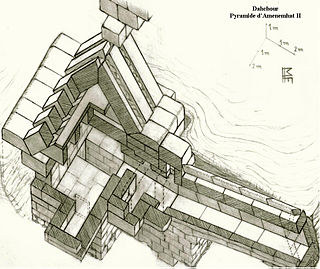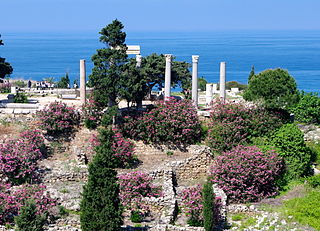
Sobekneferu or Neferusobek was a pharaoh of ancient Egypt and the last ruler of the Twelfth Dynasty of the Middle Kingdom. She ascended to the throne following the death of Amenemhat IV, possibly her brother or husband, though their relationship is unproven. Instead, she asserted legitimacy through her father Amenemhat III. Her reign lasted 3 years, 10 months, and 24 days, according to the Turin King List.

Amenemhat IV was the seventh and penultimate king of the late Twelfth Dynasty of Egypt during the late Middle Kingdom period. He arguably ruled around 1786–1777 BC for about nine regnal years.

Nubkaure Amenemhat II, also known as Amenemhet II, was the third pharaoh of the 12th Dynasty of ancient Egypt. Although he ruled for at least 35 years, his reign is rather obscure, as well as his family relationships.

Senusret II was the fourth pharaoh of the Twelfth Dynasty of Egypt. He ruled from 1897 BC to 1878 BC. His pyramid was constructed at El-Lahun. Senusret II took a great deal of interest in the Faiyum oasis region and began work on an extensive irrigation system from Bahr Yussef through to Lake Moeris through the construction of a dike at El-Lahun and the addition of a network of drainage canals. The purpose of his project was to increase the amount of cultivable land in that area. The importance of this project is emphasized by Senusret II's decision to move the royal necropolis from Dahshur to El-Lahun where he built his pyramid. This location would remain the political capital for the 12th and 13th Dynasties of Egypt. Senusret II was known by his prenomen Khakheperre, which means "The Ka of Re comes into being". The king also established the first known workers' quarter in the nearby town of Senusrethotep (Kahun).

Hor Awibre was an Egyptian pharaoh of the early 13th Dynasty in the late Middle Kingdom.

Neferuptah or Ptahneferu was a daughter of the Egyptian king Amenemhat III of the 12th Dynasty. Her sister was the Pharaoh Sobekneferu.

The White Pyramid of Amenemhat II is located in the pyramid field at Dahshur, Egypt, and is now nothing more than a pile of rubble, having been heavily quarried for stone. The remaining limestone rubble has given rise to its modern name.

Sithathoriunet was an Ancient Egyptian king's daughter of the 12th Dynasty, mainly known from her burial at El-Lahun in which a treasure trove of jewellery was found. She was possibly a daughter of Senusret II since her burial site was found next to the pyramid of this king. If so, this would make her one of five known children and one of three daughters of Senusret II—the other children were Senusret III, Senusretseneb, Itakayt and Nofret.
Nubhetepti-khered was an ancient Egyptian king's daughter of the Thirteenth Dynasty. She is only known from her undisturbed burial at Dahshur which was discovered in 1894 by Jacques de Morgan, close to the pyramid of Amenemhat III.
Keminub was an ancient Egyptian woman with the title king's wife. She is only known from her burial next to the pyramid of Amenemhet II at Dahshur. For that reason, it has been suggested she was his wife.

Amenhotep was an ancient Egyptian treasurer and royal sealer of the Thirteenth Dynasty. The treasurer was one of the most important officials at the royal court.

Sithathor was an ancient Egyptian princess with the title king's daughter. She is only known from her burial at Dahshur. Next to the pyramid of king Senusret III were found underground galleries as a burial place for royal women. Most of the burials were found looted, but there were two boxes for jewellery overlooked by tomb robbers. Both boxes contained an outstanding collection of jewellery. They were called the first and the second treasure of Dahshur. The first treasure was discovered on 6 March 1894 and belonged most likely once to Sithathor. Several scarabs with her name were found. The treasure contained a pectoral with the names of king Senusret II, one of the masterpieces of Egyptian goldwork. Other objects were golden shells, golden bracelets, a mirror and several stone vases. Sithathor is not known for sure outside her tomb. She was perhaps a daughter of Senusret III, but it is also possible that she was the daughter of Senusret II and buried as sister of king Senusret III next to him.

The pyramid of Senusret III is an ancient Egyptian pyramid located at Dahshur and built for pharaoh Senusret III of the 12th Dynasty.
Hathorhotep was an ancient Egyptian king's daughter at the end of the Twelfth Dynasty during the Middle Kingdom.

Mereret was an Ancient Egyptian King's Daughter known from her burial next to the Pyramid of Pharaoh Senusret III at Dahshur. On the north side of the king's pyramid was a row of four pyramids belonging to the king's wives. These pyramids were connected by an underground gallery. On the west side of the gallery were further burials arranged for women with the title king's daughter. They were buried in sarcophagi that were placed into niches. All burials were found looted. However, the robbers missed two boxes filled with personal adornments found in 1894 by Jacques de Morgan. One of these boxes must have belonged to a king's daughter Sithathor, the other box to a king's daughter with the name Mereret or Meret.
Senetsenebtysy was an ancient Egyptian king's daughter of the Twelfth Dynasty, around 1800 BC. She was most likely a daughter of king Senusret III.

Khenmet was an ancient Egyptian king's daughter of the Twelfth Dynasty, around 1800 BC. She is mainly known from her unrobbed tomb containing a set of outstanding personal adornments.

The Ka statue of King Hor dates to the Thirteenth Dynasty of Ancient Egypt around 1750 BC. It is now on display in the Egyptian Museum in Cairo and regarded as one of the major works of Egyptian art.

Ita was an Ancient Egyptian king's daughter who lived in the 12th Dynasty around 1850 BC. She is known from the statue of a sphinx found in Qatna in modern Syria. The statue is today in the Louvre. On this statue she bears the titles noblewoman (iryt-p`t) and king's daughter of his body. She is perhaps further known from her burial next to the pyramid of king Amenemhat II at Dahshur. The burial was found intact and contained a decorated wooden coffin with longer religious texts including her name and a set of precious personal adornments, including a richly adorned dagger. It is uncertain whether both women are identical. The location of the tomb might indicate that she was a daughter of Amenemhat II.

The royal necropolis of Byblos is a group of nine Bronze Age underground shaft and chamber tombs housing the sarcophagi of several kings of the city. Byblos is a coastal city in Lebanon, and one of the oldest continuously populated cities in the world. The city established major trade links with Egypt during the Bronze Age, resulting in a heavy Egyptian influence on local culture and funerary practices. The location of ancient Byblos was lost to history, but was rediscovered in the late 19th century by the French biblical scholar and Orientalist Ernest Renan. The remains of the ancient city sat on top of a hill in the immediate vicinity of the modern city of Jbeil. Exploratory trenches and minor digs were undertaken by the French mandate authorities, during which reliefs inscribed with Egyptian hieroglyphs were excavated. The discovery stirred the interest of western scholars, leading to systematic surveys of the site.















